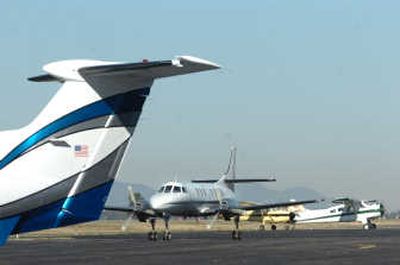CdA airport hits the jet age

It wasn’t that long ago that a private jet landing at the Coeur d’Alene Airport/Pappy Boyington Field sparked a real rubberneck moment, the kind that transformed the saltiest of airport hands into Lookie Lous.
The sky reflected in Lake Coeur d’Alene suggests that’s no longer the case. Inland Northwest community airports are rapidly changing largely because of noncommercial flights, which have ushered some into the private jet age and others into real estate market of leisure hangars. The trend has yet to hit cruising speed, say experts.
“There’s so many jets we hardly notice them anymore,” says Greg Delavan, airport manager at Coeur d’Alene Airport/Pappy Boyington Field. “Sometimes I look up, but we’ve become so accustomed to them.”
Delavan pegs the annual landings and takeoffs for all aircraft at his airport at 337 daily, a number that has been fairly stable since it was reported in 2004 by airport tracker Airnav.com. Private jet traffic, on the other hand, has been rising, though hard numbers to that effect are nonexistent. Unlike larger airports with control towers that monitor the comings and goings of every plane, community airports lacking towers aren’t required to record their activity.
There are roughly a dozen locally owned corporate jets, like the one owned by Stimson Lumber Co., which flies in and out of Coeur d’Alene regularly, Delavan said. But a growing contributor to jet traffic is relatively new to aviation: jets that are fractionally owned, or “interval ownership” jets, as Delavan calls the craft.
“It’s like timeshare for corporate jets,” Delavan said. “Used to be it cost $5 million to $50 million to get into corporate jet travel. Now you buy a share. They’re professionally operated aircraft. It’s a little more affordable at $500,000.”
Four different companies offer jet timeshares. NetJets, owned by Omaha billionaire Warren E. Buffett, is the largest and one of the companies seen taking off and landing at Coeur d’Alene Airport. Bombardier, manufacturer of Challenger and Learjets, offers fractional ownership as small as a 1/16 share and lands in Coeur d’Alene, as well. The other two companies on the national scene are Citation Shares and Flight Options. The latter is owned by defense contractor Raytheon.
Delavan said he knows of a local physician’s wife who calls often on the couple’s timeshare jet, though he wouldn’t blow her cover. The jets aren’t based in Coeur d’Alene. Rather, they fly in to pick up customers and take them whereever they want. A 1/16 ownership gives a person roughly 50 hours of fly time, which does not include fly costs of more than $1,500 an hour. There are also monthly fees that cost $6,000 or more.
If a $500,000 buy-in is too pricey, there are also “flight cards,” good for fixed amounts of time in the sky. This year, NetJet offered flight cards for as little as $115, 990.
Nationally, timeshare jet ownership began growing by about 1,000 shares a year in 2001, according to the National Business Aviation Association. A decade earlier, there were only 71 shares in the industry. In 2004, the most recent year for which statistics were available, there were 6,217 shares. Long security lines and ever-increasing flight delays after the terrorist attacks of Sept. 11, 2001, made timeshare jets attractive to people who could afford it.
“9/11 really seemed to kick them into high gear,” said Larry Booher, of Southfield Aviation. Southfield is one of two companies at Coeur d’Alene Airport fueling small jets.
There are some local timeshare ownerships, as well as jet owners with second or third homes on Lake Coeur d’Alene, that contribute to increased jet traffic, Booher said.
“We had a load of guys in a Gulfstream. All they do is go to various golf courses,” Booher said. “We see some of that.”
Farther north in Sandpoint, work has begun on a luxury subdivision of 44 airplane hangars with living quarters upstairs and a taxiway to Sandpoint Airport, owned by Bonner County. Developers of SilverWing at Sandpoint, completed their taxiway work this fall and plan to being selling lots next year for a price that hasn’t been disclosed. Pictures of what the hangars might look like, as well as a layout of the subdivision can be found online at www.silverwing atsandpoint.com.
The developing company of SilverWing at Sandpoint LLC is based in California. President John McKeown said the project is so unique it would be hard to find a similar one in the United States. He’s had to do some explaining when pilots from around the country have inquired about buying because most people assume they’ll have to lease the land on which their hangar is built, which is nearly always the case for hangars located at government-owned airports. However, SilverWing is on private land beside the airport with its own taxiway to public property, which is unusual. Live-in hangars are strictly taboo on public airports and most often found in private airparks where pilots live beside private runways.
However, private runways are usually too small to accommodate jets and large aircraft. McKeown said his development will cater to planes requiring the length and quality of a public runway.
“We just signed two leases on a couple of the buildings last week. We’ll have buildings up in June and models available for people to come look at,” McKeown said. “We’d researched everywhere. We looked and looked and Sandpoint from an aviation standpoint just offered fabulous flying. You can fly a seaplane. There are all kinds of backcountry strips, which if you’ve been flying a long time, is a real challenge. There’s the ski resort and some other developments.”